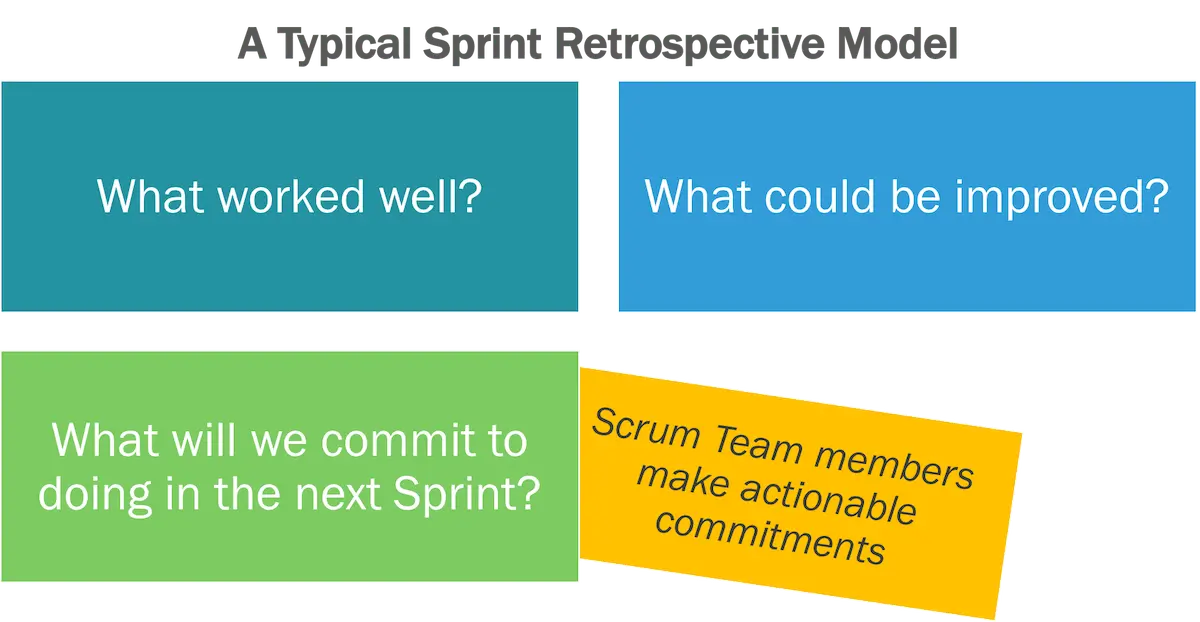If you’re interested in product management, you may have found yourself exploring the Scrum methodology. And as you’ll have quickly realized, there are plenty of new concepts and jargon to get your head around.
A key concept within Scrum, for example, is that of the sprint—a short time-boxed period during which a team works towards a defined set of goals. Following each sprint, some important meetings also take place. And one of these is the sprint retrospective.
But what exactly are they? Why are they important and what’s involved? In this article, we aim to answer all the questions you didn’t know you had about sprint retrospectives. We’ll get right back to basics, using plain English to demystify any jargon as we go.
We’ll cover the following topics:
- What is a sprint retrospective?
- Sprint retrospective FAQs
- How product managers use sprint retrospectives
- Wrap-up
Ready for a no-fuss breakdown? Then let’s dive in.
1. What is a sprint retrospective?
Before we get to the ins and outs of the sprint retrospective, it might help to have a very quick recap of the broader Scrum approach. So let’s do that.
What is Scrum?
The Scrum methodology is an iterative, incremental approach to product development.
It involves teams working towards a defined set of goals in short time-boxed periods, known as sprints. There are several sprints in each project (the exact number depends on the overall objective) and each is punctuated by several important meetings, or “ceremonies”, that keep the process on track.
One of these meetings, or ceremonies, is called the sprint retrospective, or retro.
Want to learn more about the overall methodology?
Check out our simple guide to Scrum for product managers.
Introducing the sprint retrospective
Okay, so we’ve established some foundational context. But what exactly is a sprint retrospective?
A sprint retrospective is a scrum ceremony that brings teams together at the end of each sprint to reflect on the process. The meeting helps teams identify what went well, what went less well, and how they might improve the process for future sprints.
It generally concludes with the group committing to what they will change in the upcoming sprint. If deemed necessary, changes are included in the upcoming sprint’s backlog (essentially a list of tasks that need completing).

Sprint retrospectives are safe environments where teams can openly discuss their successes and failures without fear of criticism or blame. This ensures that all team members can be honest, driving constant improvement so that upcoming sprints are more effective and efficient.
2. Sprint retrospective FAQs
Now we know what they involve and what their purpose is, here are answers to some common questions you might have about them:
When do you have a sprint retrospective?
The sprint retrospective is one of four key Scrum ceremonies (the others being the sprint planning meeting, the daily stand-up, and the sprint review).
It’s always held at the end of each sprint and should take place directly following the sprint review. Because it is focused on how to improve the overall process, the retrospective must occur before planning begins for the next sprint.
Sprint retrospective vs sprint review: What’s the difference?
We’ve just mentioned that the sprint retrospective follows the sprint review. But what’s the difference between the two?
We can answer this by looking at a) what each meeting involves and b) what each meeting’s purpose is.
In terms of what each involves, the sprint review focuses on what was achieved during the sprint. In this respect, it’s a dispassionate summary of the activity that occurred, the goals met, and those that weren’t. Meanwhile, the retrospective involves reflecting less on what was achieved and more on how.
In terms of purpose, the sprint review is a key project checkpoint that informs the goals of the next sprint. Meanwhile, the retrospective adopts a far broader mindset, looking at processes, collaboration, and team dynamics. Its ultimate aim is to improve the overall Scrum process and how the team works together.
Who runs a sprint retrospective?
Like other Scrum ceremonies, the sprint retrospective is typically facilitated by the scrum master.
Their responsibility is to ensure the meeting takes place and is productive and meaningful for the team. The scrum master typically presents a few questions to the team to help facilitate the discussion. However, the team should be encouraged to share their own ideas and topics, too.
If you want to learn more about what they do, check out our introductory scrum master guide.
Who attends a sprint retrospective?
Since the retrospective is a collaborative effort, the whole scrum team should attend. This includes the product manager, the development team, and the scrum master. Each team member brings a unique perspective, and this is invaluable for helping others learn.
Other product stakeholders, such as executives, marketing teams, or business representatives, might also attend the sprint retrospective. However, unless specifically invited, their presence isn’t usually required.
Since this meeting is more about the process than the product, they’re more likely to attend the sprint review, which focuses on the latter. If they attend the retrospective, it’s typically as an observer.
How long should a sprint retrospective last?
For a one-month sprint, a sprint retrospective typically lasts about three hours. This allows the team to conduct a forensic analysis of the process and how it went. If the sprint is shorter, the retrospective is usually shorter, as well, to reflect this.

3. How product managers use sprint retrospectives
We now know what sprint retrospectives are, what they involve, and how they fit into the broader Scrum process.
But exactly what role do product managers play in this process? And how do sprint retrospectives shape their responsibilities? Let’s take a look.
Reviewing product development progress
In the Scrum process, product managers play a key role in overseeing product development.
Retrospectives are, therefore, vital for helping them identify areas for improvement based on what they hear and see. Changes might come from their own observations, from the broader team, or by reviewing feedback from other stakeholders, such as customers.
For example, if the team was recently working on a new feature, the product manager might use the retrospective to assess progress on the feature’s design, usability, and impact. Depending on the team’s input, this could inform changes to the development process that ensures the development of new features are more effective and efficient in future.
Solving communications issues
Alongside assessing product development, the sprint retrospective allows product managers to gather broader feedback (both positive and negative) about issues around communication.
This can help them identify changes that need to occur beyond the scope of the development lifecycle. By evaluating their perspective alongside other team members, they can assess any difficulties the team is facing as objectively as possible.
For example, they might uncover areas of friction in their communication style or conflicts between team members that might impact productivity. The product manager can then use these insights to adjust their strategy accordingly, for instance, by helping team members overcome their differences or assigning them to roles that minimize their interaction.
Maintaining team morale
Often, simply sharing their thoughts is enough for a team to feel more valued. Sprint retrospectives provide an ideal outlet for this. Product managers can ensure the team’s perspectives are listened to, and that input and feedback are heard.
Creating a safe space for honest conversation and encouraging team members to take ownership of their work helps give them a greater sense of purpose and achievement. The sprint retrospective is also a good opportunity to praise positive work and collaboration to boost morale.
Adopting best practices
A sprint retrospective isn’t just a place to identify what went wrong. It’s also an opportunity to acknowledge successes and good practice.
Since best practice often arises spontaneously, acknowledging strength areas allows the product manager to adopt them more formally by embedding them into the process.
Identifying risks and opportunities
Finally, sprint retrospectives also help product managers identify upcoming risks and opportunities. The retrospective is the one time when the whole team comes together to evaluate customer and product data and jointly agree on a forward approach.
For example, if the product manager notices that customers are using the product in a way that was not anticipated, the team might use this information to determine that given features need optimization. These tasks can then be added to the backlog for the upcoming sprint.
The sprint retrospective’s impact on the product manager’s role isn’t limited to those listed here. In reality, the meeting’s impact depends on factors from the size of the organization to the makeup of the team and the product under development. But being a successful product manager means effectively utilizing the sprint retrospective to its full potential.
4. Wrap-up
In this guide, we’ve unpicked the sprint retrospective in detail. As we’ve learned, it’s a key meeting within the Scrum methodology and one that product managers should take the time to understand.
A sprint retrospective is a valuable tool for the whole team. However, it’s key for helping product managers identify improvement areas and ensuring that everyone’s energy is focused on the right objectives. With an effective retrospective at the end of each sprint, product managers can ensure their teams are continuously learning, improving, and growing.
Got more questions about a possible career in product management? Then check out this free 5-day product management short course. Otherwise, if you prefer to keep on reading, here are some more introductory articles:

